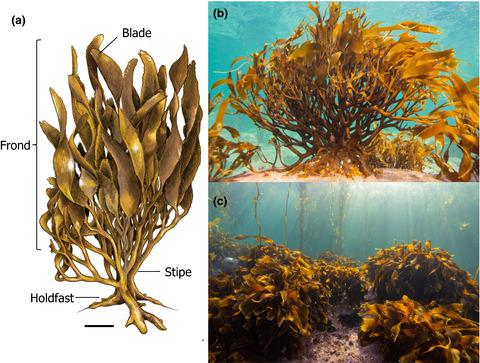当前位置:
X-MOL 学术
›
Ecol. Evol.
›
论文详情
Our official English website, www.x-mol.net, welcomes your feedback! (Note: you will need to create a separate account there.)
Disentangling the links between habitat complexity and biodiversity in a kelp‐dominated subantarctic community
Ecology and Evolution ( IF 2.6 ) Pub Date : 2021-01-15 , DOI: 10.1002/ece3.7100 Catalina Velasco‐Charpentier 1, 2 , Felipe Pizarro‐Mora 2 , Nelso P. Navarro 3, 4 , Nelson Valdivia 4, 5
Ecology and Evolution ( IF 2.6 ) Pub Date : 2021-01-15 , DOI: 10.1002/ece3.7100 Catalina Velasco‐Charpentier 1, 2 , Felipe Pizarro‐Mora 2 , Nelso P. Navarro 3, 4 , Nelson Valdivia 4, 5
Affiliation

|
Habitat complexity is one of the most important factors modulating species diversity. This feature comprises several interrelated attributes, such as number, size, and spatial arrangement of complexity‐forming elements. However, the separate and joint effects of these attributes on diversity and community structure are still not well understood. Here, we assess the relationships between several structural‐complexity attributes of the subantarctic kelp Lessonia flavicans and species richness, total abundance, and structure of kelp‐associated macrobenthic communities. We predicted that longer thalli and larger holdfasts favor greater species richness and total abundance of invertebrate organisms. To test the prediction, an observational sampling program was established in two sites of the Strait of Magellan. Uni‐ and multivariate analyses revealed both positive and negative effects of kelp structural‐complexity attributes on diversity. Holdfast diameter and maximum frond length, followed by thallus wet weight, had the strongest positive fits to species richness and total abundance; the number of stipes, on the other hand, was negatively associated with both response variables. Longer fronds were associated with greater abundances of spirorbid polychaetes. Larger holdfasts supported larger abundances of Nereididae and Terebelidae polychaetes and the limpet Nacella mytilina. Contrarily, kelps with longer fronds and more stipes supported fewer amphipods. In this way, we demonstrate that different dimensions of habitat complexity can have contrasting effects on diversity and community structure, highlighting the fundamental role of multiple dimensions of kelp habitat complexity for local biodiversity.
中文翻译:

解开海带主导的亚南极群落中栖息地复杂性与生物多样性之间的联系
栖息地的复杂性是调节物种多样性的最重要因素之一。此功能包括几个相互关联的属性,例如复杂性形成元素的数量,大小和空间排列。但是,这些属性对多样性和社区结构的单独影响和共同影响仍未得到很好的理解。在这里,我们评估了南极海藻海藻黄褐藻的几种结构复杂性属性之间的关系。以及海带相关大型底栖动物群落的物种丰富度,总丰度和结构。我们预测,更长的塔利和更大的固着力有利于更大的物种丰富度和无脊椎动物生物的总丰度。为了检验这一预测,在麦哲伦海峡的两个地点建立了观测抽样程序。单变量和多变量分析揭示了海带结构复杂性属性对多样性的正面和负面影响。保持直径和最大叶长度,然后是th的湿重,对物种丰富度和总丰度具有最强的正拟合;另一方面,针刺的数量与两个响应变量均呈负相关。较长的叶与更多的螺旋藻多毛虫相关。吊舱菌。相反,具有更长叶状和更多柄的海带支持较少的两栖动物。通过这种方式,我们证明了生境复杂性的不同维度可以对多样性和群落结构产生相反的影响,突出了海藻生境复杂性的多个维度对于当地生物多样性的基本作用。
更新日期:2021-02-05
中文翻译:

解开海带主导的亚南极群落中栖息地复杂性与生物多样性之间的联系
栖息地的复杂性是调节物种多样性的最重要因素之一。此功能包括几个相互关联的属性,例如复杂性形成元素的数量,大小和空间排列。但是,这些属性对多样性和社区结构的单独影响和共同影响仍未得到很好的理解。在这里,我们评估了南极海藻海藻黄褐藻的几种结构复杂性属性之间的关系。以及海带相关大型底栖动物群落的物种丰富度,总丰度和结构。我们预测,更长的塔利和更大的固着力有利于更大的物种丰富度和无脊椎动物生物的总丰度。为了检验这一预测,在麦哲伦海峡的两个地点建立了观测抽样程序。单变量和多变量分析揭示了海带结构复杂性属性对多样性的正面和负面影响。保持直径和最大叶长度,然后是th的湿重,对物种丰富度和总丰度具有最强的正拟合;另一方面,针刺的数量与两个响应变量均呈负相关。较长的叶与更多的螺旋藻多毛虫相关。吊舱菌。相反,具有更长叶状和更多柄的海带支持较少的两栖动物。通过这种方式,我们证明了生境复杂性的不同维度可以对多样性和群落结构产生相反的影响,突出了海藻生境复杂性的多个维度对于当地生物多样性的基本作用。


























 京公网安备 11010802027423号
京公网安备 11010802027423号